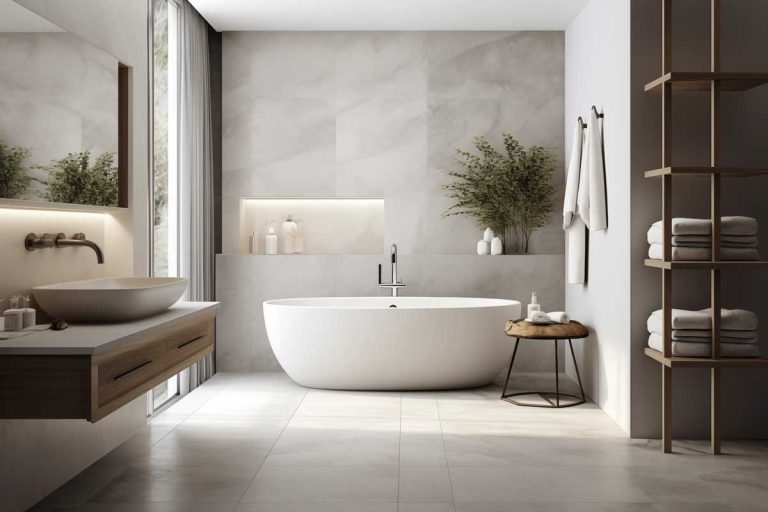The National Kitchen & Bath Association (NKBA | KBIS) has released its 2026 Bath Trends Report. Based on a survey of nearly 700 industry experts, the report provides a comprehensive look at current and upcoming trends in residential bathrooms that will have the most significant impact in 2026 and beyond.
According to the report, the bathroom design landscape is currently in a state of flux – the evolution of bathroom technology marks an upcoming shift emerging in the home. As residential tech continues to present more opportunities and innovation, three areas of growth in the bath are standing out:
- Technology in Design Inspiration: Younger homeowners are turning to AI for design inspiration that integrates smart features, sustainability, and style.
- Technology in Fixtures: Smart home integration is expanding rapidly through intelligent showers, lighting, and energy systems.
- Technology for Wellness: Health-oriented features, stress-reduction tools, and ageing-in-place innovations are becoming mainstream.
Beyond technology, personalised tastes and lifestyles continue to be the driving force behind colour, style, and material selection, as well as storage configurations and bath layout.
“Bath design is becoming deeply personal,” said Bill Darcy, Global President & CEO of NKBA | KBIS. “Beyond considerations like resale value, designers are focusing on how spaces support a homeowner’s individual rituals, preferences, and self-care routines. This perspective encourages creativity, niche trends, and designs that truly reflect how people live today.”
The full report is available at NKBA.org with free access for NKBA members. Key findings include:
Colours & Materials: What’s In, What’s Out
- Light Neutrals Win: In near total agreement, 96% of respondents identified neutrals as the most popular bath colours, with off-white (58%), light brown/tan (54%), and white (40%) earning the dominant response ahead of dark brown (30%), black (18%), and dark gray/slate (18%).
- Shades of Green: Brown-based greens – sage (64%) and olive (43%) – are expected to be popular choices, while bolder hues – teal/turquoise (19%) and emerald/juniper (16%) – received far less attention.
- Timeless Design: Transitional/timeless design tops the list, with 70% of respondents naming it as a popular style in the next three years.
- Removing Fine Lines: Homeowners are looking for smaller or no grout lines on the floor, according to 89% of those surveyed. Additionally, 91% agree that durability and practicality to minimise upkeep are the top considerations for choosing a flooring material, supporting 80% who believe large-format flooring will be the most popular over the next three years.
- Natural Materials: Wood-faced vanities (62%) have overtaken painted (53%) in popularity as biophilic design continues to be prioritised in the bath.
- Polished Is Out: For taps, matte (54%), brushed (51%), and satin (46%) finishes were more popular than polished (39%), playing into organic, natural design cues.
A Growing Footprint
The overall bathroom footprint will increase to accommodate wellness-centred spaces, universal design considerations, and efficient storage solutions, according to 72% of respondents.
Hospitality Inspiration for Wellness
Tying bath design to a homeowner’s hotel or resort experience is expected to be a popular practice, according to 77% of respondents, supporting the unification of wellness, technology, and sustainability into a singular, cohesive design philosophy. This isn’t about one individual feature like a smart toilet (though 51% agree smart toilets will rise in popularity over the next three years) or a new tile colour (patterned and textured tiles are gaining prominence, according to 66%). Instead, it’s a fundamental shift in how we perceive and use the primary bathroom. It’s moving from a purely utilitarian space to a sanctuary dedicated to physical and mental well-being, while also being smart and environmentally conscious.
Seeing the Light
Lighting quality is a top consideration in bathroom design, according to 91% of respondents. In practice, this means prioritising layers and levels of lighting:
- Task Lighting: 92% agree that task lighting should always be included in the primary bath
- Mood Lighting: 51% predict that mood lighting in the shower will gain prominence
- Time-of-Day Lighting: 80% include nighttime-specific lighting, and 88% list natural lighting as a top priority
- Aesthetic Lighting: 47% favour integrated lighting in mirrors over the next three years
Custom Bathroom Solutions
On a larger scale, smart technology is being integrated to achieve a more personalised daily ritual and as a tool to improve overall well-being. On a simpler level, custom storage solutions with configurable modules to simplify life are being thoughtfully integrated into bath vanity and cabinetry design. Item-specific storage includes built-in storage for hair tools, makeup, and medications, electrical integration, custom dividers and organisers to maximise drawer efficiency, and charging stations for electronic devices within vanity cabinetry.
Accessibility is Elegant
Ageing-in-place design elements have become so mainstream that, in addition to functionality, these universal design fixtures also prioritise beauty. Grab bars, curbless showers, shower benches, barrier-free shower entries, and wider doors are subtle yet crucial safety features that make a primary bath feel more luxurious and elevated. Of those surveyed, 32% agree that ageing-in-place is now a mainstream trend; 48% agree that it’s on its way to becoming one.


